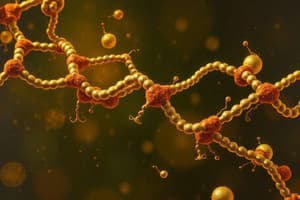Podcast
Questions and Answers
What is the fundamental unit of a cell called?
What is the fundamental unit of a cell called?
- Cellular building block (correct)
- Cell organelle
- Nucleus
- Mitochondria
Which organelle is responsible for energy production through cellular respiration?
Which organelle is responsible for energy production through cellular respiration?
- Mitochondria (correct)
- Chloroplasts
- Nucleus
- Cell membrane
What is the function of the cell membrane?
What is the function of the cell membrane?
- Cell adhesion and communication (correct)
- Regulating gene expression
- Synthesizing proteins
- Energy production through respiration
Which organelle is the control center of the cell?
Which organelle is the control center of the cell?
Which organelle is responsible for synthesizing proteins?
Which organelle is responsible for synthesizing proteins?
What is the primary function of mitochondria in a cell?
What is the primary function of mitochondria in a cell?
Which organelle is involved in protein synthesis and translation in a eukaryotic cell?
Which organelle is involved in protein synthesis and translation in a eukaryotic cell?
What is the main role of the Golgi apparatus in a cell?
What is the main role of the Golgi apparatus in a cell?
Which organelle is involved in synthesizing complex carbohydrates and lysosome biogenesis?
Which organelle is involved in synthesizing complex carbohydrates and lysosome biogenesis?
What is the function of the rough endoplasmic reticulum (ER) in a cell?
What is the function of the rough endoplasmic reticulum (ER) in a cell?
Flashcards are hidden until you start studying
Study Notes
The Building Block: Understanding the Fundamental Unit of a Cell
At the heart of life's complexity lies the cell, the smallest unit capable of carrying out the essential functions of living organisms. The fundamental unit of a cell, the smallest indivisible entity that constitutes a living cell, is the cellular building block that we'll delve into here.
The Cellular Building Block: Structure and Composition
The fundamental unit of a cell, called the cell organelle or organelle, is an organ-like structure with a specific function to support the life of the cell. Some common organelles include the nucleus, mitochondria, and chloroplasts.
The cell membrane is the first structure one encounters in understanding the fundamental unit of a cell. It's a flexible, selectively permeable barrier that separates the cell's interior from its environment, and it contains embedded proteins and lipids. The cell membrane plays a crucial role in cellular transport, adhesion, and communication.
The Cell Nucleus: DNA's Home
The cell nucleus is the control center of the cell, housing the cell's genetic material, DNA. It's a membrane-bound organelle responsible for synthesizing proteins, regulating gene expression, and controlling the cell cycle. The nucleus is also involved in DNA repair and replication.
Mitochondria: The Cell's Powerhouses
Mitochondria are the cell's powerhouses, responsible for energy production through cellular respiration. They convert nutrients such as fatty acids, glucose, and oxygen into ATP (adenosine triphosphate), the cell's primary energy currency. Mitochondria contain their own DNA and ribosomes, which allows them to synthesize some of their proteins.
Chloroplasts: Factories of Photosynthesis
Chloroplasts are unique organelles found in plant cells and some algae. They're responsible for photosynthesis, the process by which plants and some other organisms convert sunlight into chemical energy in the form of glucose. Chloroplasts contain their own DNA and ribosomes, enabling them to synthesize some of their proteins.
Ribosomes: Protein Synthesis and Translation
Ribosomes are cellular organelles responsible for protein synthesis and translation—the process of converting information encoded in messenger RNA (mRNA) into a specific sequence of amino acids, which fold into a functional protein. Ribosomes consist of two subunits, large and small, and are present in the cell's cytoplasm.
The Endoplasmic Reticulum: Folding and Transporting Proteins
The endoplasmic reticulum (ER) is an extensive network of membrane-bound tubules and sacs that are involved in protein synthesis, modification, and transport. There are two types of ER: rough ER (covered with ribosomes) and smooth ER (not covered with ribosomes). The rough ER is primarily involved in protein synthesis and folding, while the smooth ER is involved in lipid synthesis, detoxification, and calcium storage.
The Golgi Apparatus: Sorting and Packaging
The Golgi apparatus is a flattened, sac-like organelle responsible for sorting, modifying, and packaging proteins and lipids synthesized in the ER and other cellular components. The Golgi apparatus also plays a crucial role in cellular secretion, lysosome biogenesis, and the synthesis of complex carbohydrates.
Conclusion
The fundamental unit of the cell—organelles and their associated functions—are the building blocks that enable cells to carry out their essential functions. Understanding these unique structures and their functions is critical in grasping the complexity and interconnectedness of life's smallest units. Becker, B., Babu, M. M., & Simons, K. (2015). Cell organelles: Structure and function. In B. Becker, M. M. Babu, & K. Simons (Eds.), Cell organelles (pp. 1-30). Springer International Publishing. Alberts, B., Johnson, A., Lewis, J., Raff, M., Roberts, K., & Walter, P. (2015). Molecular Biology of the Cell (6th ed.). Garland Science. Lodish, H., Berk, A., Zipursky, S., Matsudaira, P., & Baltimore, D. (2000). Molecular Cell Biology (4th ed.). W.H. Freeman and Company. Voet, D., Voet, J., & Pratt, C. (2016). Fundamentals of Biochemistry (9th ed.). Wiley. Alberts, B. (2002). Molecular Biology of the Cell (4th ed.). Garland Science. Campbell, N. A., Reece, J. B., Urry, L. A., Cain, M. L., Wasserman, S. A., Minorsky, P. V., ... & Jackson, R. B. (2008). Biology (7th ed.). Benjamin Cummings. Berg, J. M., Tymoczko, J. L., & Stryer, L. (2002). Biochemistry (5th ed.). W.H. Freeman and Company.
Studying That Suits You
Use AI to generate personalized quizzes and flashcards to suit your learning preferences.




